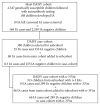Assessing age-related etiologic heterogeneity in the onset of islet autoimmunity
- PMID: 25883970
- PMCID: PMC4389824
- DOI: 10.1155/2015/708289
Assessing age-related etiologic heterogeneity in the onset of islet autoimmunity
Abstract
Type 1 diabetes (T1D), a chronic autoimmune disease, is often preceded by a preclinical phase of islet autoimmunity (IA) where the insulin-producing beta cells of the pancreas are destroyed and circulating autoantibodies can be detected. The goal of this study was to demonstrate methods for identifying exposures that differentially influence the disease process at certain ages by assessing age-related heterogeneity. The Diabetes Autoimmunity Study in the Young (DAISY) has followed 2,547 children at increased genetic risk for T1D from birth since 1993 in Denver, Colorado, 188 of whom developed IA. Using the DAISY population, we evaluated putative determinants of IA, including non-Hispanic white (NHW) ethnicity, maternal age at birth, and erythrocyte membrane n-3 fatty acid (FA) levels, for age-related heterogeneity. A supremum test, weighted Schoenfeld residuals, and restricted cubic splines were used to assess nonproportional hazards, that is, an age-related association of the exposure with IA risk. NHW ethnicity, maternal age, and erythrocyte membrane n-3 FA levels demonstrated a significant age-related association with IA risk. Assessing heterogeneity in disease etiology enables researchers to identify associations that may lead to better understanding of complex chronic diseases.
Figures




References
-
- Onkamo P., Vaananen S., Karvonen M., Tuomilehto J. Worldwide increase in incidence of type I diabetes—the analysis of the data on published incidence trends. Diabetologia. 1999;42(12):1395–1403. - PubMed
-
- Patterson C. C., Dahlquist G. G., Gyürüs E., Green A., Soltész G. Incidence trends for childhood type 1 diabetes in Europe during 1989–2003 and predicted new cases 2005–20: a multicentre prospective registration study. The Lancet. 2009;373(9680):2027–2033. doi: 10.1016/S0140-6736(09)60568-7. - DOI - PubMed
Publication types
MeSH terms
Substances
Grants and funding
LinkOut - more resources
Full Text Sources
Other Literature Sources

